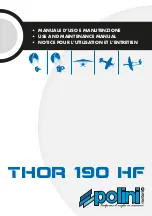
2
WORK AREA SAFETY
•
Keep work area clean and well lit.
Cluttered or
dark areas invite accidents.
•
Vacuums have motors and other parts that can
produce sparks during normal use.
Do not use
within 30 feet of areas where explosive materials
may be present (such as gasoline pumps and places
where liquids like paint thinners, cleaners, solvents,
etc. are stored).
•
Do not use in the presence of explosive dust,
liquids or vapors.
•
Do not use where oxygen or anesthetics are used.
•
Do not allow to be used as a toy.
Close attention
is necessary when used by or near children.
•
Use extra care when using on stairs.
ELECTRICAL SAFETY
• Do not handle plug or appliance with wet hands.
• Vacuum plugs must match the outlet. Never
modify the plug in any way. Do not use any
adapter plugs with earthed (grounded) vacuums.
Unmodified plugs and matching outlets will reduce
risk of electric shock.
•
Avoid body contact with earthed or grounded
surfaces, such as pipes, radiators, ranges and
refrigerators.
There is an increased risk of electric
shock if your body is earthed or grounded.
•Store Indoors. Do not expose vacuums to rain
or wet conditions.
Water entering a vacuum will
increase the risk of electric shock.
•
Do not abuse the cord. Never use the cord for
carrying, pulling or unplugging the vacuum. Keep
cord away from heat, oil, sharp edges or moving
parts.
Damaged or entangled cords increase the
risk of electric shock.
• Do not use cord as a handle, close a door on cord,
or pull cord around sharp edges or corners.
Do
not run appliance over cord. Keep cord away from
heated surfaces.
• Do not use with damaged cord or plug.
If appli-
ance is not working as it should, has been dropped,
damaged, left outdoors, or dropped into water, return
it to a service center.
•
Turn off all controls before unplugging.
Do not
unplug by pulling on cord. To unplug, grasp the
plug, not the cord.
• When operating a vacuum outdoors, use an
extension cord suitable for outdoor use.
Use of
a cord suitable for outdoor use reduces the risk of
electric shock.
• If operating a vacuum in a damp location is
unavoidable, use a ground fault circuit interrupter
(GFCI) protected supply.
Use of an GFCI reduces
the risk of electric shock.
PERSONAL SAFETY
•
STAY ALERT.
Watch what you are doing and use
common sense. Do not use vacuum when you are
tired, distracted or under the influence of drugs,
alcohol or medication causing diminished control.
•
The operation of a vacuum can result in foreign
objects being blown into eyes,
which can result in
eye damage. Always wear safety goggles or glasses
with side shields when operating vacuum.
•
Wear a dust mask or use an OSHA compliant
vacuum solution
when working in dusty situations.
Dust particles can harm your lungs.
•
Do not overreach. Keep proper footing and bal
-
ance at all times.
This enables better control of the
vacuum in unexpected situations.
•
Keep hair, loose clothing, fingers, and all parts
of body away from openings and moving parts.
•
Use only as described in this manual.
Use only
manufacturer’s recommended attachments.
•
Prevent unintentional starting. Ensure the switch
is in the off-position before connecting to power
source, picking up or carrying the vacuum.
Carrying vacuums with your finger on the switch or
energizing vacuums that have the switch on invites
accidents.
• If devices are provided for the connection of
dust extraction and collection facilities, ensure
these are connected and properly used.
Use of
dust collection can reduce dust-related hazards.
•
Do not let familiarity gained from frequent use
of tools allow you to become complacent and
ignore tool safety principles.
A careless action can
cause severe injury within a fraction of a second.
VACUUM USE AND CARE
•
Do not use without dust cannister and/or filter
in place.
•
Do not use to pick up flammable or combustible
liquids
such as gasoline or use in areas where they
may be present.
•
Do not pick up anything that is burning or smok
-
ing
such as cigarettes, matches, or hot ashes.
•
Do not pick up soot, cement, plaster or drywall
dust without filter in place.
These are very fine
particles that may affect the performance of the
motor or be exhausted back into the air.
•
This product is suitable for collection of silica
dust when used in accordance with these in-
structions. To reduce the risk of health hazards
from other vapors or dust, do not vacuum
carcinogenic, toxic or hazardous materials
such as asbestos, arsenic, barium, beryllium, lead,
pesticides or other health endangered materials.
•
Use special care when emptying heavily loaded
tanks.
•
To avoid spontaneous combustion, empty dust
box after each use.
•
Do not leave vacuum unattended when plugged
in.
Unplug when not in use and before servicing.
•
Disconnect the plug from the power source before
making any adjustments, changing accessories, or
storing vacuums.
Such preventive safety measures
reduce the risk of starting the vacuum accidentally.
IMPORTANT SAFETY INSTRUCTIONS
WARNING
WHEN USING AN ELECTRICAL VACUUM, BASIC
PRECAUTIONS SHOULD ALWAYS BE FOLLOWED. BE-
FORE USING THE VACUUM, READ THIS OPERATOR’S MANUAL AND ALL
LABELS ON THE VACUUM.
FAILURE TO FOLLOW THE WARNINGS AND
INSTRUCTIONS MAY RESULT IN ELECTRIC SHOCK, FIRE AND/OR SERIOUS
INJURY.



































